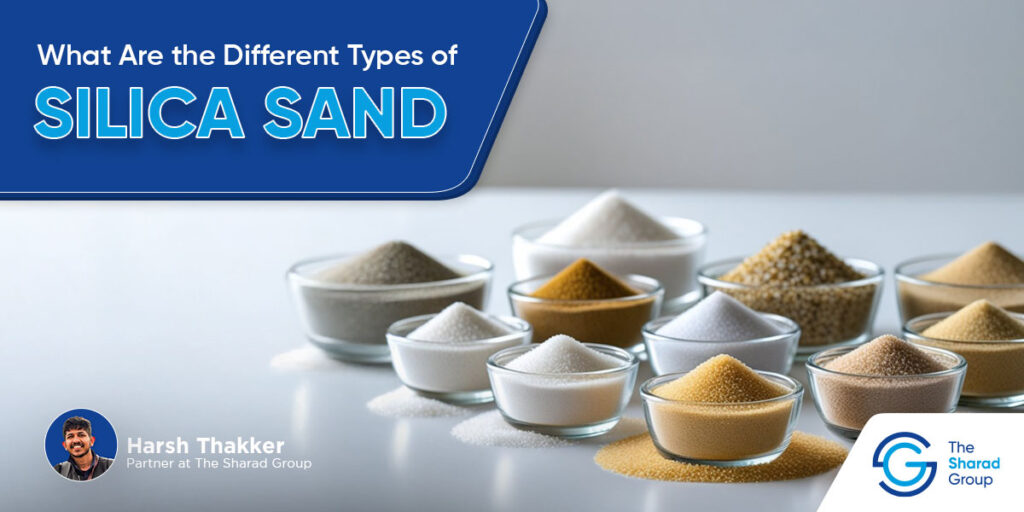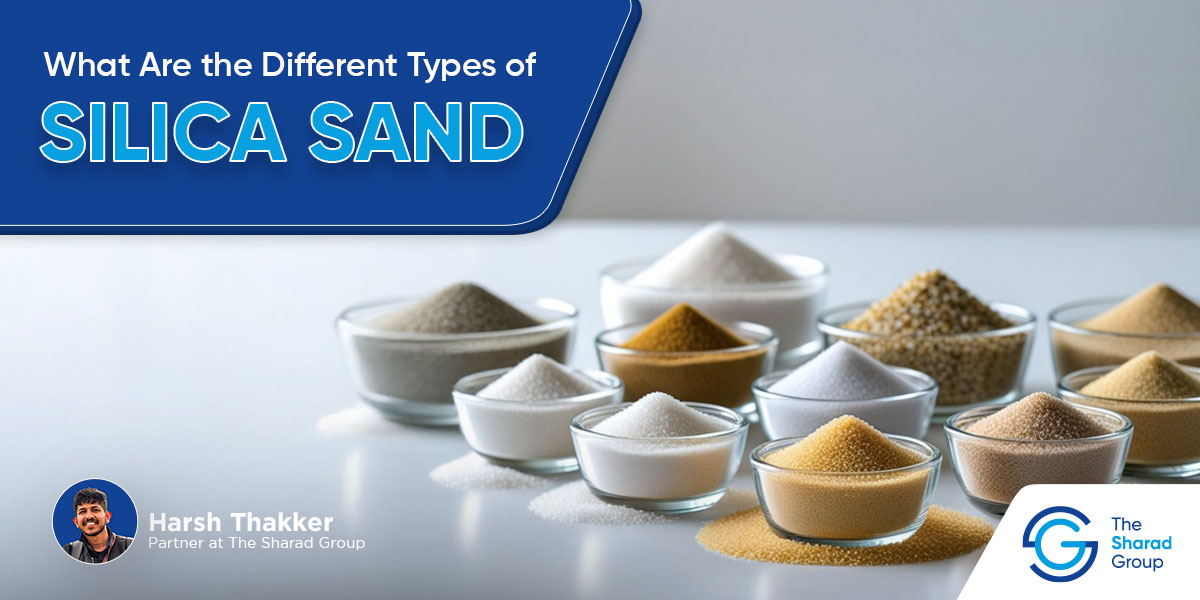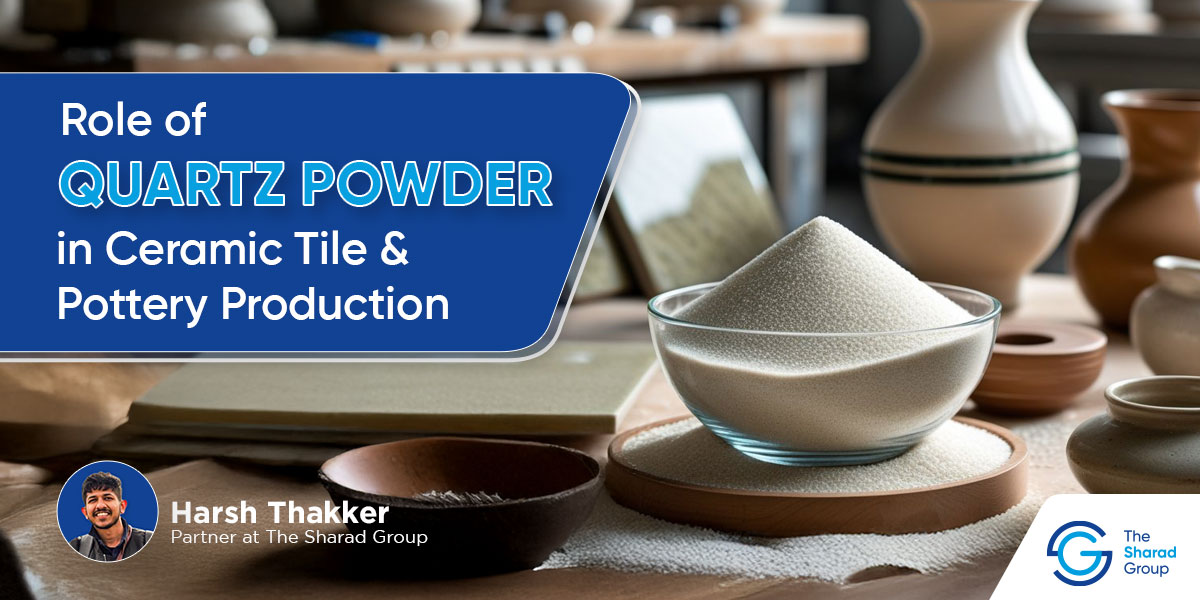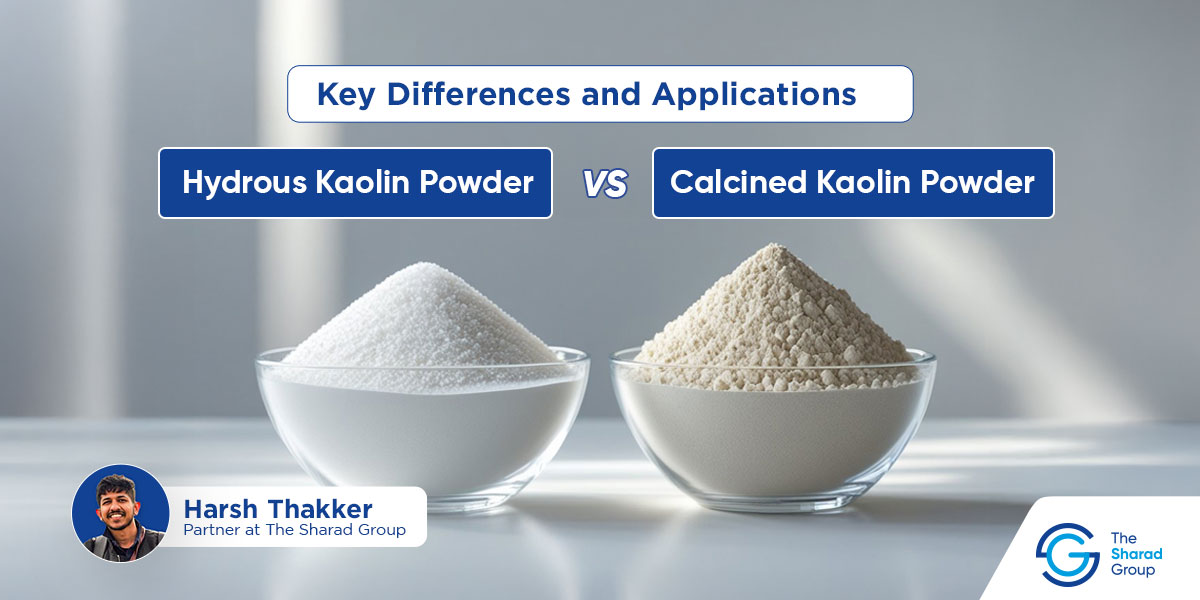Have you heard that silica sand is one of the best industrial raw materials, but don’t know which type is right for you?
If so, I’m glad you’re here!
As of 2025, the global silica sand market is worth around $26 billion. You can find it in fracking equipment, glassware, water filtration systems, and even solar batteries.
And all of these industries have slightly different silica sand uses and requirements.
These different types are divided mainly according to three things:
- The deposit/source of the silica sand.
- The purity of the sand – the content of silica dioxide.
- The industrial applications of silica sand.
In this blog, I’ve used all my experience and expertise in the mining industry to break down the 7 different types of silica sand. You’ll find a detailed section for each type of quartz sand, along with its properties, appearance, and use cases.
Dive in to find out which silica sand is right for you!
Types of Silica Sand: Table of Contents
- Types of Silica Sand: Detailed Table of Comparison
- The 7 Types of Silica Sand: Appearance, Composition, Applications
- The Sharad Group: Your Silica Sand Suppliers in India
- Types of Silica Sand: FAQs
Types of Silica Sand: Detailed Table of Comparison
In this section, I’ve given a detailed breakdown of the 7 major types of silica sand.
The table tells you how to identify the different types of silica sand, their composition, and key industrial applications.
| Type of Silica Sand | Appearance | Composition & Key Characteristics | Key Industrial Applications |
| Glass-Making Sand | Typically bright white or off-white. Fine, uniform grains. | >99.5% SiO₂. Very low iron oxide content. High chemical purity and thermal stability. | Manufacturing of containers, flat, and speciality glass; fiberglass. |
| Foundry Sand | Tan to light brown. Coarse, angular grains. | 95-99% SiO₂. High refractoriness and permeability. | Creating molds and cores for metal casting (e.g., automotive parts). |
| Frac Sand | Milky white. Perfectly round and spherical grains. | >99% SiO₂. Exceptionally high crush resistance. | Propping open fractures in hydraulic fracturing (fracking) for oil/gas. |
| Filter Sand | Off-white to beige. Rounded, size-graded grains. | >95% SiO₂. Chemically inert. Acid-resistant. | Water filtration (municipal, wastewater, swimming pools). |
| Abrasive Sand | Grey to brown. Very coarse and angular grains. | >95% SiO₂. High hardness (Mohs 7). | Sandblasting, surface preparation, grinding, and polishing. |
| Construction Sand | Tan, brown, or reddish due to impurities. Variable grain size and shape. | 80-95% SiO₂. Contains varying levels of clay, silt, and other minerals. | Concrete, mortar, asphalt, roofing shingles, bedding material. |
| Specialty Sands (Golf, Playground) | Pure white (golf). Light beige (playground). Rounded grains. | >95% SiO₂. Washed and sterilized. Non-compacting. | Golf course bunkers, children’s play sand, sports fields. |
What's on this page:
ToggleThe 7 Types of Silica Sand: Appearance, Composition, Applications
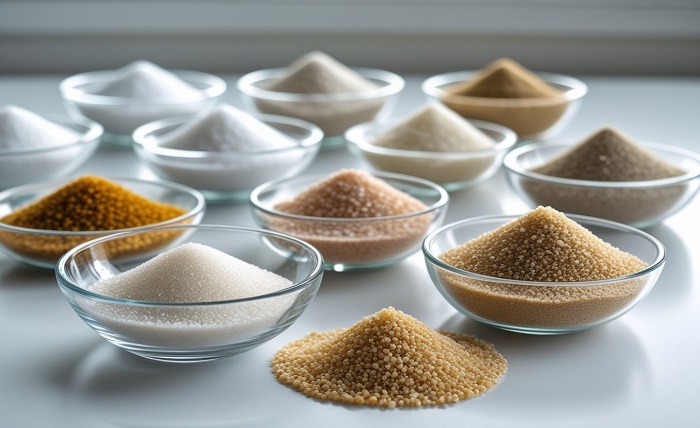
1. Glass-Making Sand
Glass-making sand remains one of the most widely available and used types of silica sand in the world.
It is also the type of quartz sand with the highest growth in demand in the world. In addition to this, it is also the purest grade of silica sand, which is why it’s often called “white silica sand”.
Let me show you how and why.
Glass-Making Silica Sand Composition and Definition
Glass-making sand is a high-purity silica sand. This means it contains at least 99.5% SiO₂, and can go up to 99.99% purity!
This also means that it has extremely low iron oxide content (<0.6%). This is what ensures clarity and prevents discoloration in glass materials produced with this sand.
Characteristics of Glass-Making Sand
- Physical Characteristics:
- Fine-grained (consistent quality).
- Uniform particle size (0.1–0.6 mm).
- Angular to sub-rounded grains.
- Chemical Properties:
- Chemically inert (won’t react with other chemicals, for eg. in test tubes).
- high melting point of ~1,713°C (can hold hot liquids).
- Excellent thermal stability (perfect for making glass lab equipment).
Mining Regions of Glass-Making Sand
Glass-making silica sand is mined from high-purity deposits that are typically found in the U.S. (mainly in Illinois & Wisconsin), Australia, and China.
Applications of Glass-Making Sand
As its name suggests, glass-making sand is typically used in making glass products. This includes containers, flat cups, fibreglass, borosilicate glass, and more.
So, if you’re looking for the perfect raw material for your glass manufacturing industry, this is the type of sand you need!
Additional Info on Glass-Making Sand
Remember, glass-making quartz sand properties need to be very specific. This means it requires strict quality control to ensure that it is free of impurities like iron and alumina. Such impurities can easily lead to defective glass products – either in appearance or sturdiness.
So, be sure to work with a reliable silica sand manufacturer to source your glass-making quartz sand!
2. Foundry Sand
Foundry sand is a moderately pure form of quartz sand. It is commonly used to manufacture heavy and light metal equipment.
One of the most important reasons this sand is in high demand right now is the depletion of natural sand resources around the world.
Let me walk you through its particulars:
Foundry Silica Sand Composition and Definition
Foundry sand is silica sand with moderate silicon dioxide content. Its purity usually ranges between 95–99% SiO₂.
It’s also often blended with binders like clay to increase the strength of the moulds cast with it.
Characteristics of Foundry Sand
- Physical Characteristics:
- Coarse-grained (0.5–1.0 mm).
- Angular grains for better bonding.
- High permeability.
- Chemical Properties:
- High refractoriness (prevents molten metal from entering the mould).
- resistant to molten metal erosion (making it useful in automotive parts).
Mining Regions of Foundry Sand
Foundry silica sand is found in regions like Wisconsin and Minnesota in the U.S., and regions with St. Peter Sandstone formations. It’s also found in ancient Indian silica sand deposits in Rajasthan.
Applications of Foundry Sand
The main application of foundry sand is mould creation and metal casting. This makes it one of the best raw materials for the automotive, plumbing, road building, and construction activities.
Additional Info About Foundry Sand
One of the best things about Foundry Sand is that repeated reuse can actually increase its stability. This is due to the formation of cristobalite, which leads to better strengthening and sturdiness of the structures created with foundry sand.
3. Frac Sand
Frac sand is one of the purest grades of silica sand. It is named after its main application – to act as a “proppant” that keeps fractures open during mining or welling processes.
It’s therefore one of the most in-demand grades of silica sand.
Frac Silica Sand Composition and Definition
Frac sand is high-purity quartz sand with a purity of ≥99% SiO₂. It is composed of spherical, crush-resistant grains, which give it its strength during fracking processes.
Let me show why this is the case through its characteristics.
Characteristics of Frac Sand
- Physical Characteristics:
- Uniform grain size (0.4–0.8 mm).
- High sphericity that prevents compaction.
- Crush resistance (>6,000 psi).
- Chemical Properties:
- Low clay content.
- Inert to acidic environments.
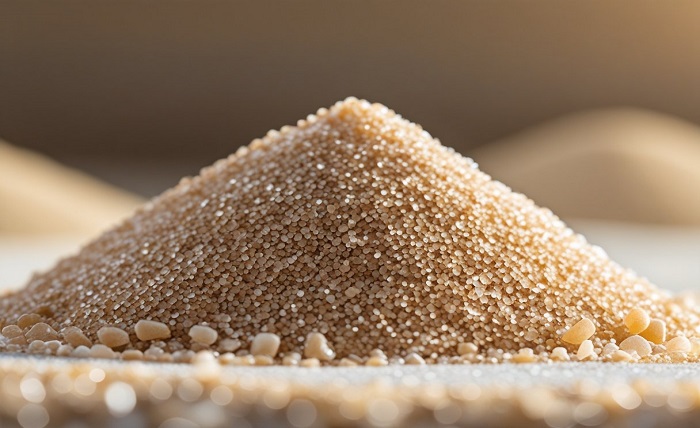
Mining Regions of Frac Sand
One good thing about frac sand is that it is available in regions where fracking is most common, such as Wisconsin and Illinois in the U.S. It is also mined in Texas (“in-basin sand”) for logistical advantages.
The Sharad Group is one of the best frac silica sand suppliers in India. We export high-purity frac sand to all regions around the world with a very efficient supply chain operation.
Applications of Frac Sand
The most common and beneficial use of frac sand is in hydraulic fracturing, or fracking.
It is used to prop open fractures in shale rock for oil/gas extraction. So, the better your supply of frac sand, the more secure your fissures and oil/gas extraction processes.
Additional Info About Frac Sand
One very important thing you should keep in mind is that the transport costs of frac sand significantly influence its economic viability. Therefore, we recommend working with indigenous silica sand manufacturers that can guarantee a steady supply of high-grade frac sand, like The Sharag Group.
4. Filter Sand
Filter sand is a processed silica sand grade. That means it is created by refining pure silica sand deposits.
This is the sand that governments, municipalities, hotels, sports arenas, industries and contractors around the world use to clean swimming pools, water reservoirs, and industrial effluents.
Filter Silica Sand Composition and Definition
Filter sand is silica sand with ≥95% SiO₂. It is washed and graded to create a silica sand with uniform particles, which makes it useful for trapping particles suspended in water.
Characteristics of Filter Sand
- Physical Characteristics:
- Rounded grains (uniform shape).
- Manufactured in two sizes:
- 0.4–0.8 mm for water filtration.
- 0.6–1.2 mm for pool filters.
- Chemical Properties:
- Chemically inert.
- Does not degrade in acidic or chlorinated water.
Mining Regions of Filter Sand
Filter sand is mined globally. However, its largest reserves are in North America (Ohio and Michigan) and India.
Applications of Filter Sand
As its name suggests, filter sand is most commonly used to filter wastewater, ensure the safety of water in swimming pools, and for industrial effluent treatment.
Additional Info About Filter Sand
The main reason filter sand is effective is due to its uniform particle size and high drainage capacity. That means, with high-grade filter sand, you can create a filtration system that has the capacity to allow a lot of water to pass through, and thus remove impurities from it.
5. Industrial Abrasive Sand
Next on our list is industrial abrasive sand. It’s a rough grade of silica sand that is commonly used to polish surfaces and reduce other minerals to fine particles.
Industrial Abrasive Silica Sand Composition and Definition
Industrial abrasive sand is silica sand with >95% SiO₂. It thus has moderate silica content and is often coated to prevent the permeation of other particles through it.
Characteristics of Industrial Abrasive Sand
- Physical Characteristics:
- Coarse, angular grains (0.5–2.0 mm).
- A very high degree of hardness (Mohs 7).
- Chemical Properties:
- Inert but generates respirable dust requiring safety measures.
Mining Regions of Industrial Abrasive Sand
Industrial abrasive silica sand is most commonly found in deposits in the U.S. (Great Lakes region), Australia, and India.
For example, we at The Sharad Group are one of the largest industrial abrasive silica sand suppliers in India, which we source from rich deposits in Rajasthan and Gujarat.
Applications of Industrial Abrasive Sand
The most common applications of industrial abrasive sand include sandblasting, grinding, polishing, and surface preparation in shipbuilding/construction.
Additional Info About Industrial Abrasive Sand
One thing you must remember is that industrial abrasive sand can cause silicosis due to the high level of particles that it might shed during its application. However, you can easily prevent this through dust control coatings and PPE.
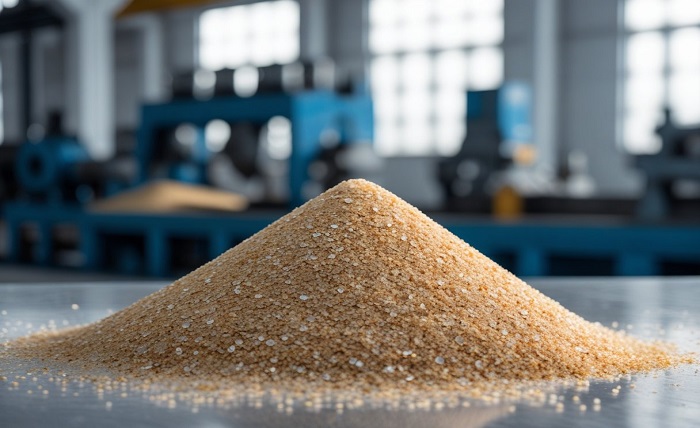
6. Construction Sand
This is the most commonly found grade of silica sand. It is therefore an affordable filler used in construction, manufacturing asphalt, and in grouting.
Construction Silica Sand Composition and Definition
Construction sand is a form of silica sand with low purity (80–95% SiO₂) that is mixed with clay, silt, and iron oxides.
It usually appears as a fine, filler material that you can easily use to add strength, stability, and mass to building materials.
Characteristics of Construction Sand
- Physical Characteristics
- Variable grain size (fine to coarse).
- Darker color due to impurities.
- Chemical Properties:
- More chemically reactive than high-purity sands, therefore unsuited to any application that requires inertness.
Mining Regions of Construction Sand
Construction sand is usually locally sourced – you can easily get it from riverbeds and beaches in and around your construction or building site.
Applications of Construction Sand
Construction sand is usually used to manufacture concrete, mortar, and asphalt. It is also used in roofing shingles and grouting processes.
Additional Info About Construction Sand
If you’re looking for sand for agricultural or landscaping purposes, construction-grade sand is the best option. It’ll act as the best filler material and will absorb fertilizers, minerals, and water more easily.
7. Speciality Silica Sand
Lastly, we get to speciality silica sands – these are created specifically for very particular applications. Let me walk you through the three most popular ones:
- Golf Course Sand
- Composition: Washed, high-purity silica sand with coarse grains.
- Characteristics: White color, excellent drainage, non-compacting.
- Applications: Bunkers, greens, and turf fields.
- Playground Sand
- Composition: Ultra-washed, fine-grained silica sand.
- Characteristics: Rounded grains, free of harmful particles.
- Applications: Safe play surfaces for children.
- Ceramics & Refractories Sand
- Composition: High-purity, fine-grained SiO₂.
- Characteristics: Controls shrinkage/expansion in ceramics.
- Applications: Tableware, tiles, refractory bricks.
Ceramics and refractory sands are usually specially refined forms of glass-making and foundry sands. They maintain a high level of purity while offering excellent strength and flexibility for moulds.
At The Sharad Group, we specialise in manufacturing and exporting high-grade ceramics and refractories, silica sand throughout the world!
The Sharad Group: Your Silica Sand Suppliers in India
The different types of silica sands make them suitable for different applications. The type of silica sand you need will depend largely on your use case.
But whether you’re not able to decide which silica sand type is right for you, or are looking for a steady silica sand supplier in India, we’re here to help!
At The Sharad Group, we have been manufacturing, supplying, and exporting high-purity silica sands to a wide range of regions and countries.
Conveniently located near one of the fastest supply chains of the world in Gujarat, we also have access to some of the richest silica sand mines and deposits in the world.
Reach out to us today to get a sample of your preferred silica sand grade and let us help you create strong, lasting, and high-quality products!
Types of Silica Sand: FAQs
1. What are the main types of silica sand?
The seven main types of silica sand are glass-making, foundry, frac, filter, abrasive, construction, and speciality sands. Each is defined by its silica sand composition, properties, and industrial use.
2. What is quartz silica sand used for?
Quartz silica sand is prized for its high purity and hardness. Its primary applications include glass manufacturing, metal casting, hydraulic fracturing (fracking), and water filtration systems across various industries.
3. Why is some silica sand white?
White silica sand indicates high purity, often exceeding 99% SiO₂, with very low iron oxide content. This makes it ideal for applications like glass-making and golf course bunkers where colour and purity are critical.
4. How do I choose a silica sand supplier?
Choose experienced silica sand suppliers in India who can verify the sand’s properties and composition for your specific needs. Reputable silica sand manufacturers provide consistent quality and reliable material testing.
5. What are the key properties of silica sand?
Key silica sand properties include chemical inertness, high melting point, hardness, and grain size/shape. These determine its suitability for applications from industrial abrasives to foundry moulds and filtration.
6. What is the difference between silica sand and quartz silica sand?
Essentially, they are the same thing. All types of silica sand are primarily composed of silicon dioxide (SiO₂). The term “quartz silica sand” is often used to specify that the SiO₂ is in its crystalline quartz form, which is the most common type. It’s frequently used to denote higher-purity sands suitable for industrial applications like glass-making or foundry work.

